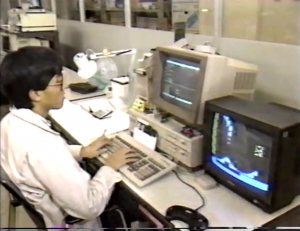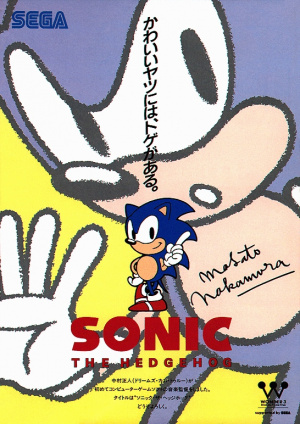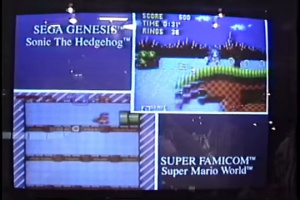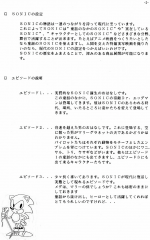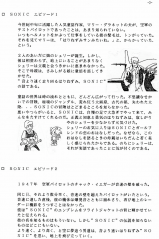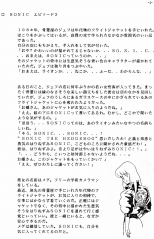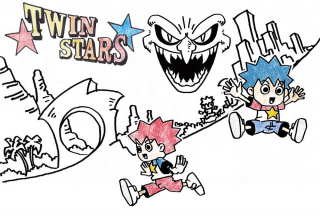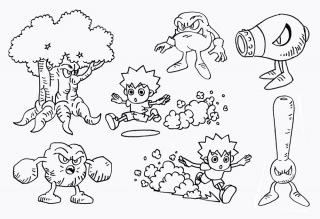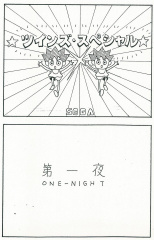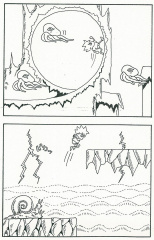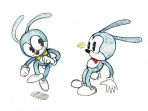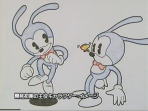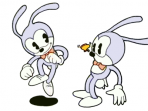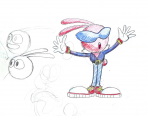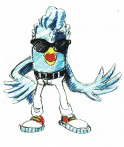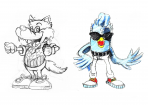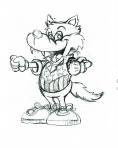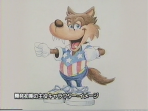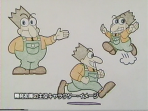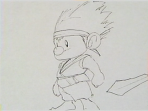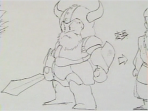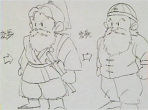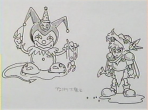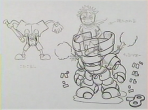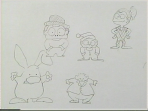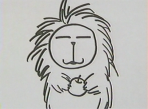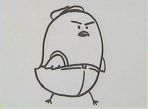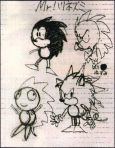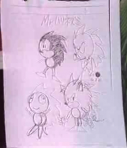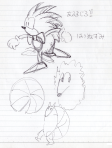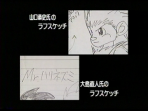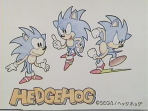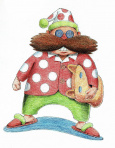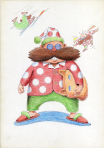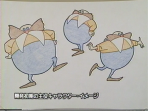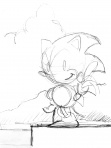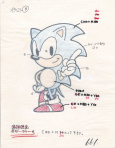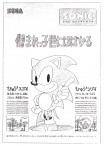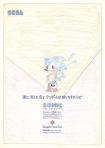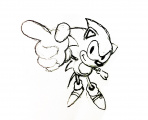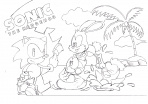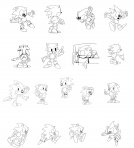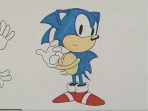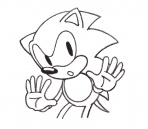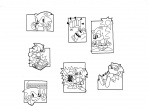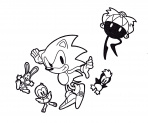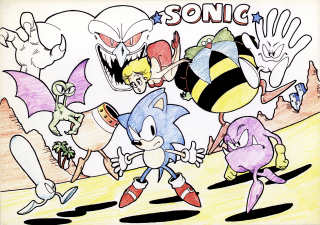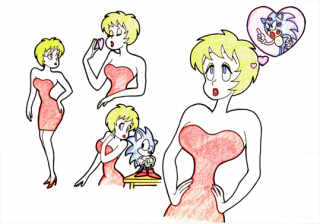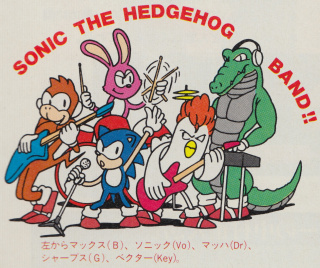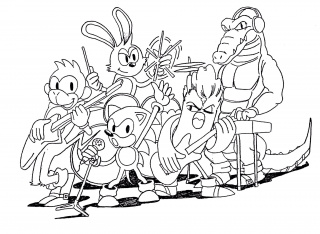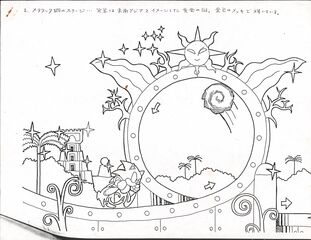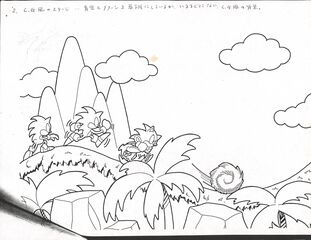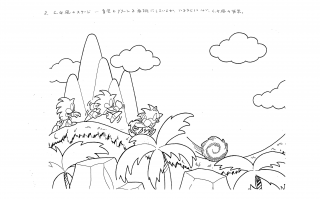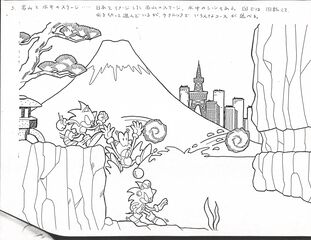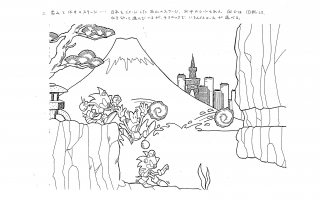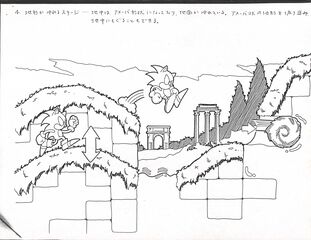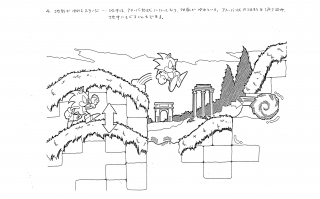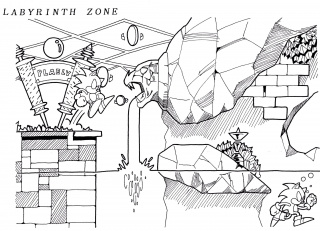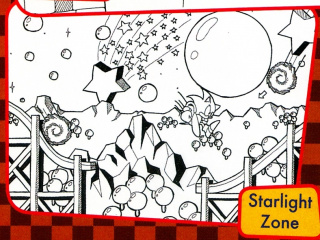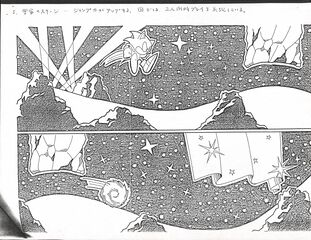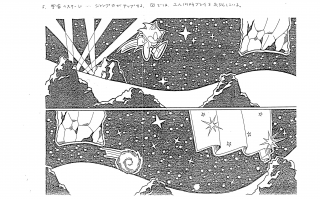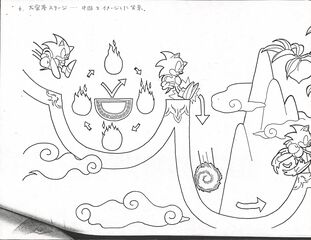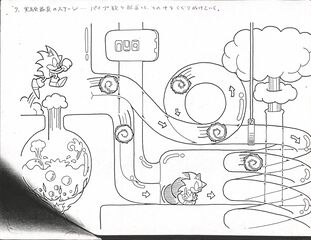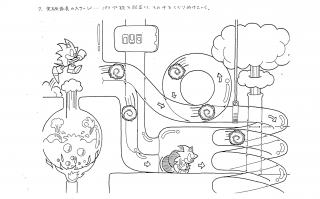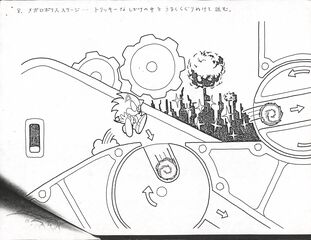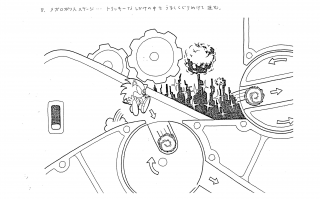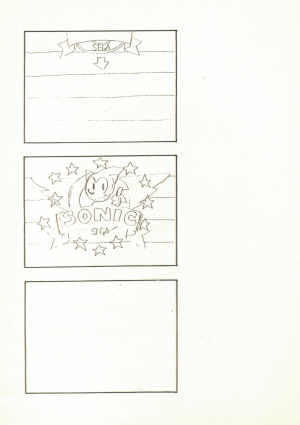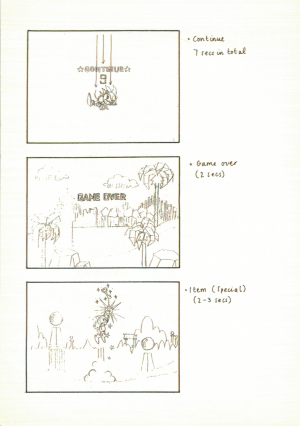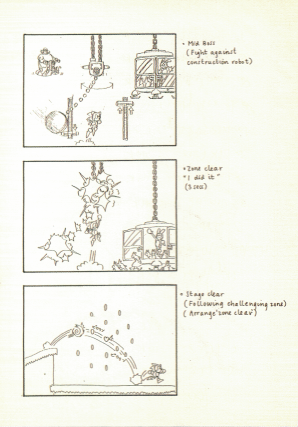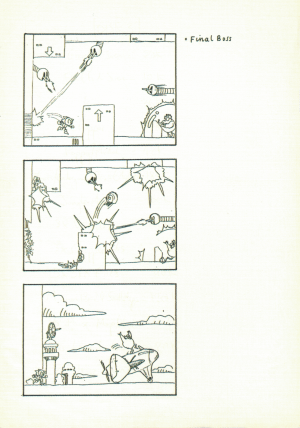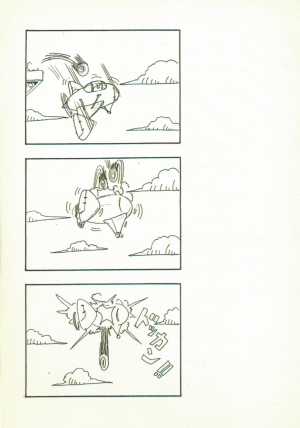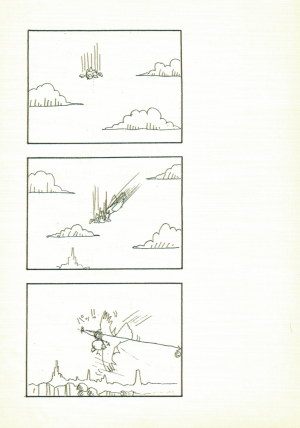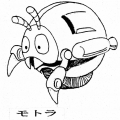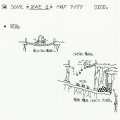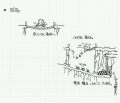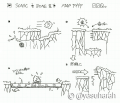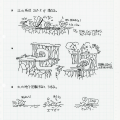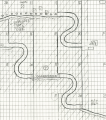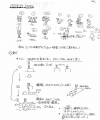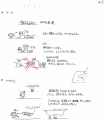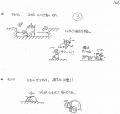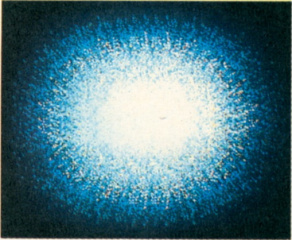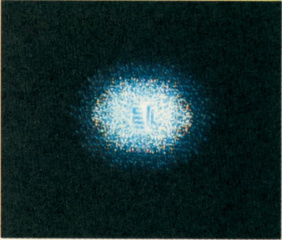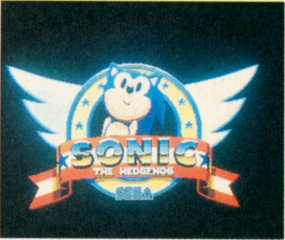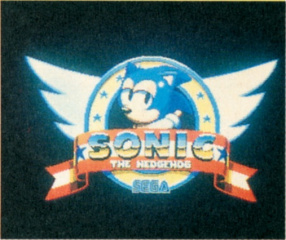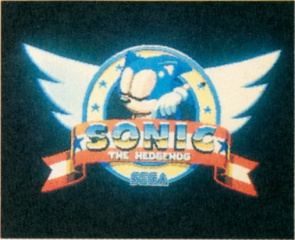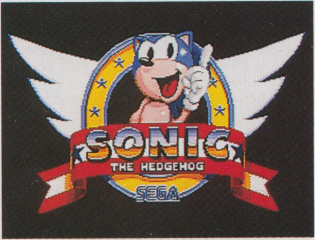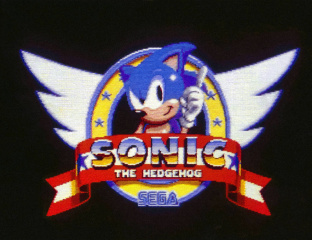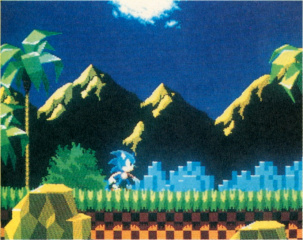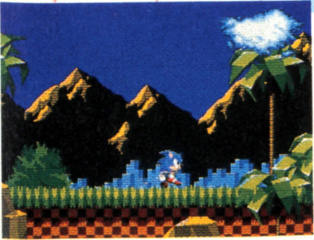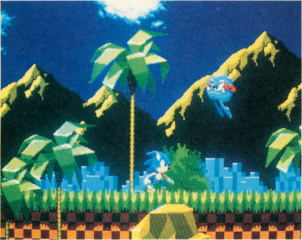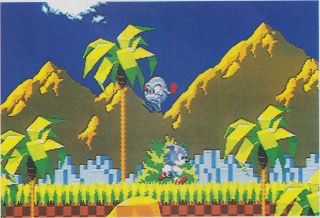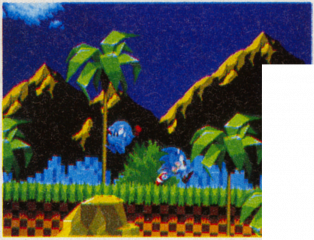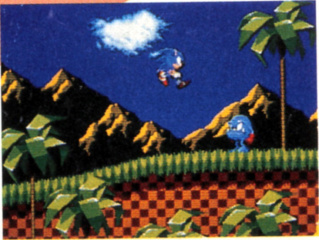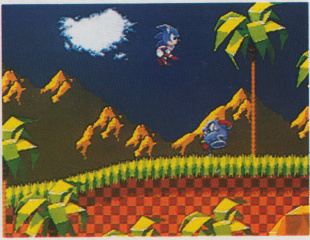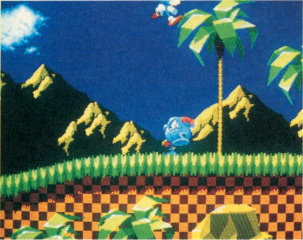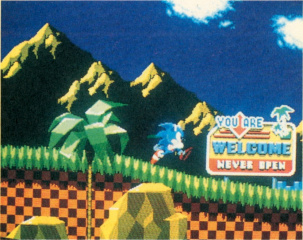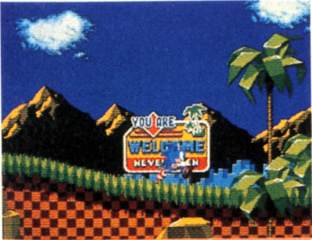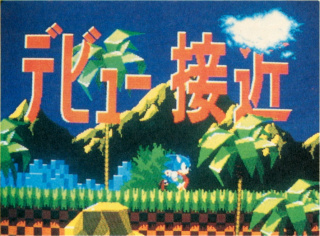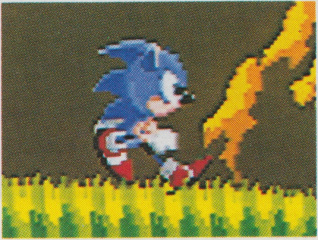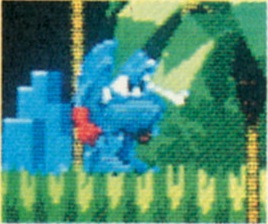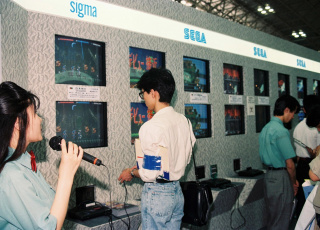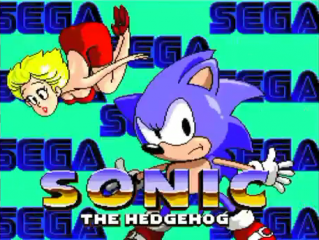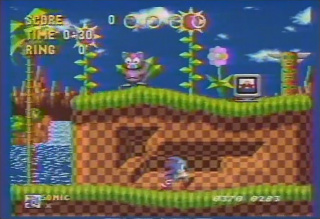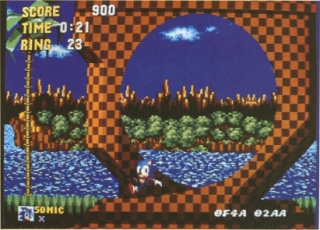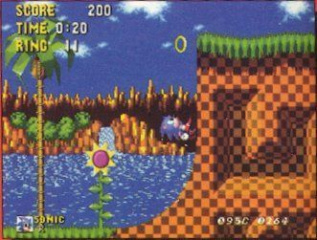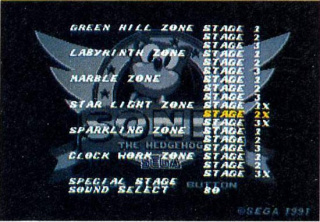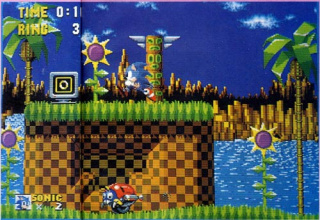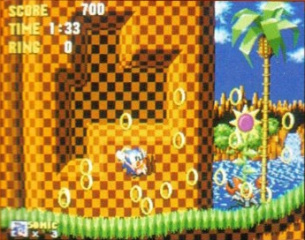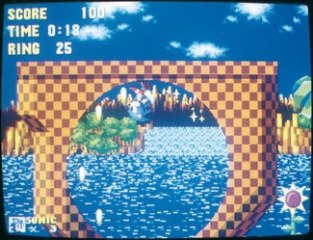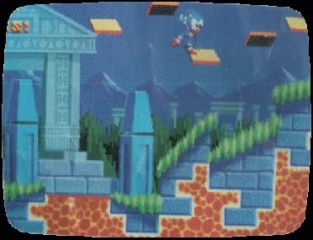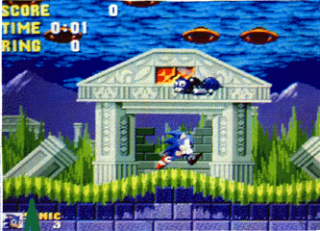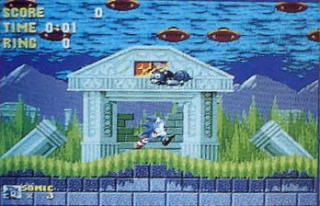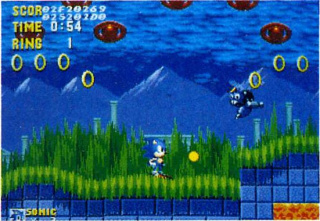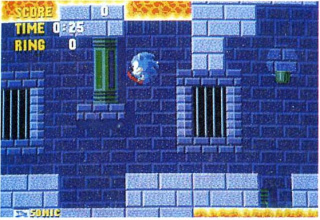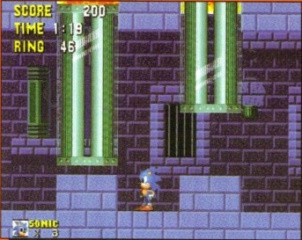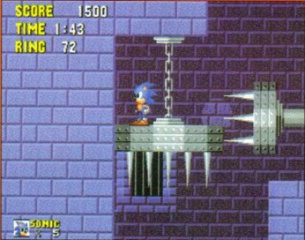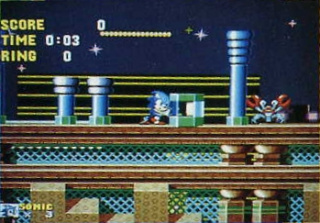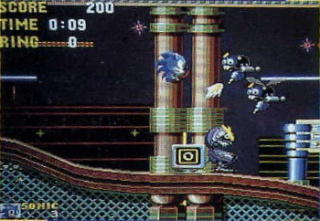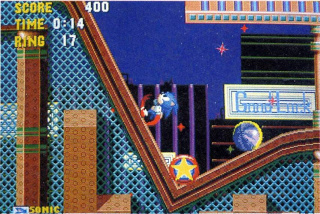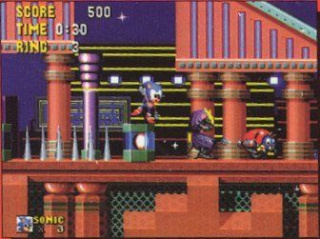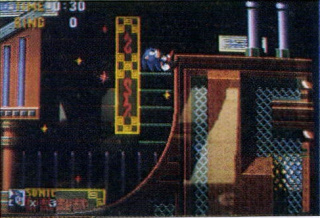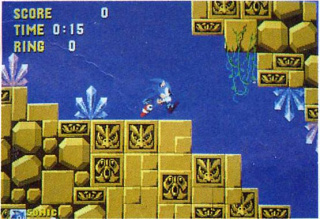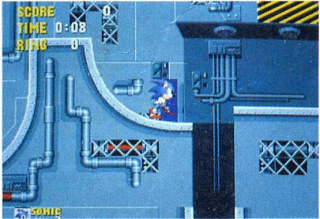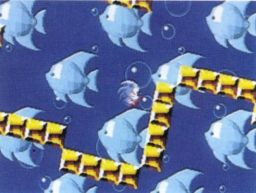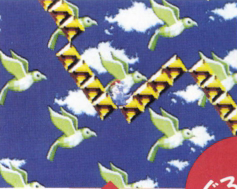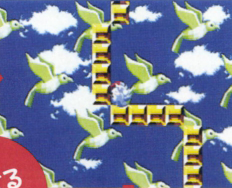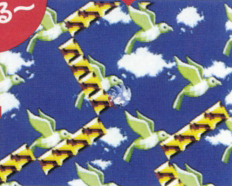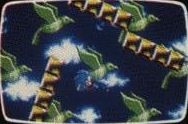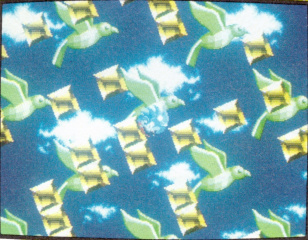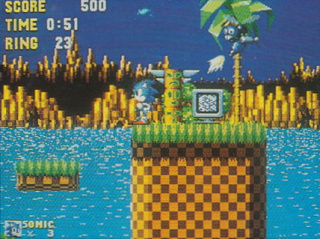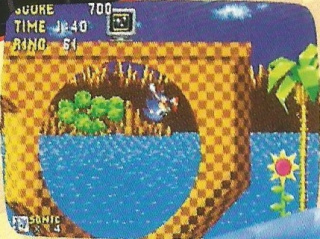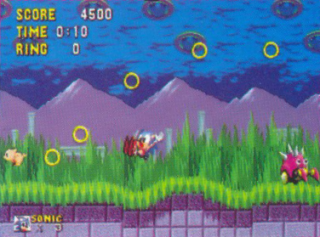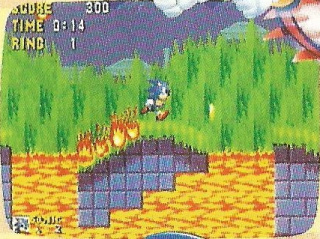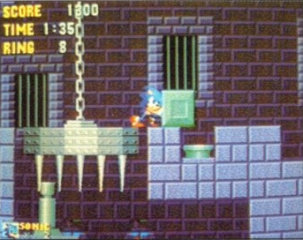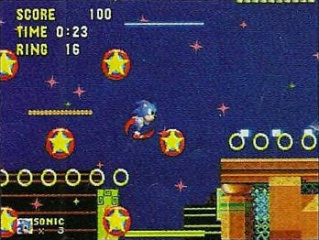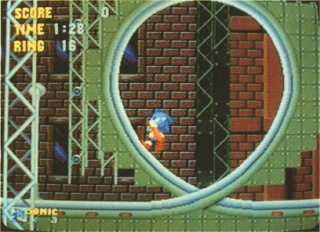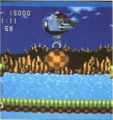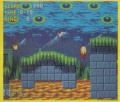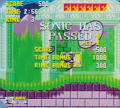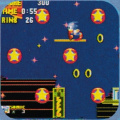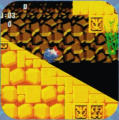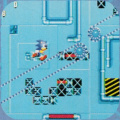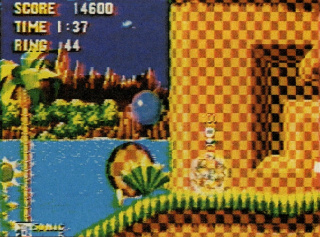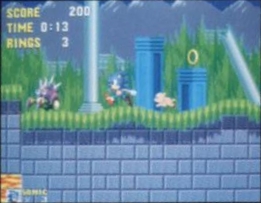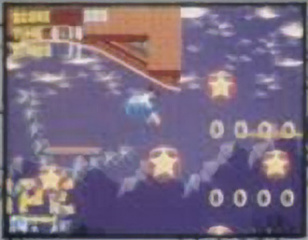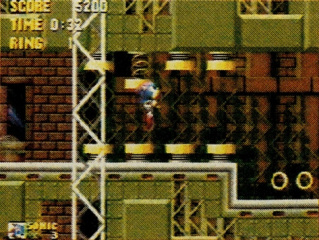Sonic the Hedgehog (16-bit)/Development
From Sonic Retro
(Redirected from Game Development:Sonic the Hedgehog (16-bit))
- Back to: Sonic the Hedgehog (16-bit).
Being the original game in the series, Sonic the Hedgehog went through a number of concepts and changes through its development process. What follows is a collection and summary of what that entailed.
Contents
- 1 Development process
- 2 Westernization
- 3 Fictional character origin
- 4 Logo design
- 5 Concept art
- 6 '90 Tokyo Toy Show
- 7 Winter Consumer Electronics Show 1991
- 8 Promotional screenshots
- 9 References
Development process
The year was 1990. While Sega was doing well in the arcades, little ground had been gained in the home video game market. Competing with Nintendo during the previous seven years, not even the launch of the Mega Drive could shake the ninety percent dominance[3] the Nintendo Entertainment System had. Sega's then-current mascot, Alex Kidd, had done little to convince the general public to invest in their hardware. Feeling it was important to have a strong mascot that not only defined Sega but could also directly compete with the Super Mario Bros series, an internal competition was held. Open to anyone who worked at the company, roughly 200 character designs were drawn up, submitted for consideration.[4]
It was during this time that Yuji Naka was looking for his next assignment within the company. After the cancellation of Metal Lancer, Naka wanted to program and design a racing game. Hoping to get the chance, he drafted up a list of game genres he wanted to work on, the racer taking the number one spot. Sending the memo to his boss, it was the final game on the list - "an action game to challenge Mario" - that caught the attention of Naka's superior.[5] At the same time, designer Naoto Ohshima was busy trying to come up with his own proposal for a video game. Influenced by his time working at an advertisement company, one of Ohshima's early goals was to create a character that could "go far beyond just being a video game character."[6] One of these concepts, entitled Twin Stars,[7] featured a speedy character that could run around loops.[8][4] Showing what he had worked on to his boss, he had a hard time getting consent to work further on the proposal.[6]However, he was told that the only person at the company who might be able to program such a game was Yuji Naka.[4] When Ohshima learned that Naka was free, he approached his fellow Phantasy Star alumni, asking if he would work with him on the game concept.[9]
The idea of a fast paced game intrigued Naka, and it didn't take long for him to accept. Quickly, the pair got to work. On the programming side, Naka found himself influenced by two prominent titles, the first being Ghouls'n Ghosts, which Naka had recently ported to the Mega Drive. The way the player could traverse smoothly across a flowing landscape[10] was something he wanted to capture, but at speeds far higher than what that title was able to achieve. The second game that influenced the thinking of what would become Sonic was the original Super Mario Bros.
| “ | I like fast things and I thought that it would be nice to create a game where the more skilled you become, the faster you can complete a stage. Games back then had no backup or saving system, which meant that you had to play right from the beginning every time...As a result, the very first stage would be played time and time again, making the player very skilled at it. So we thought it would be nice if this would enable the player to complete those stages faster and that's the basis of Sonic's speed. We also thought this feature would help differentiate Sonic from Mario. | „ |
| — Yuji Naka, Programmer and Project Manager of Sonic the Hedgehog[9] | ||
Initially, the game starred a cartoon rabbit, as they wanted a character that would embody the concept of speed.[11] The design also tied into the initial attack mechanic for the game, where the rabbit would use its ears to pick up rocks or other items, then throw them at oncoming enemies. As Naka was also insistent that the game only use one action button, the game hit a wall. The constant starting and stopping interrupted the flow of gameplay, and proved to not be all that fun.[10] It was around this time that the head of the department, Kotaro Hayashida,[12], invited Hirokazu Yasuhara to help with the development of the mascot game. At the time, Yasuhara was not expecting to remain part of their group for long.
| “ | I was supposed to go to the United States to establish a new R&D team [at Sega of America] with Mark Cerny...But then the [first] Gulf War Started, and my move to the US was postponed for three months. Work was progressing on the [new mascot] game, but Naka and Ohshima needed a full-time game designer on the project. They saw that I was free, and looked to me for help designing the game until my departure. So I officially joined the project as a game designer, planning to work on it only until I went to the US. But I ended up staying in Japan for a year until we finished the project. | „ |
| — Hirokazu Yasuhara, Director and Lead Game Designer of Sonic the Hedgehog[13] | ||
Yasuhara was quick to agree that how the game was currently meant to be played wasn't shaping up. Knowing of Naka's insistence on the simplistic control scheme, he told the team that the only way the player would be able to deal damage was by using the jump mechanic.[14] The trio tried to find a solution, Naka at one point saying to the group "all your ideas, anything you've been hiding, cough it up now!"[15] But with nothing new, Naka relented on revealing his own secret idea, one he had come up with in high school and was hoping to keep to himself for a future, non-Sega game. That idea was a somersault attack, one that wouldn't just be the character curling up into a ball while airborne, but one that could also be used on the ground, rolling about the terrain.[15][5] While Ohshima was at first skeptical,[16] it proved to be the answer for their quandary.
With this change in gameplay, the idea of a rabbit suddenly made less sense.[5] It was clear that a new protagonist would need to be designed, but what form that would take was up in the air. At the core, the team wanted to make sure the character defined Sega, something they felt had been missing from the company's previous attempt at created a mascot character.[17] One aspect of this was the concept of "cool," not just on a superficial level, but also in their personality, wanting to fight for what they believed in but not being ordered around by others. The other aspect they wanted to be sure the character held was being a challenger, evoking the 90's sensibilities that were forming, and also reflecting on how Sega was trying to challenge Nintendo at their own game.[17]

Ohshima went back to the drawing board, doodling up a variety of potential character ideas. Suggestions came from a number of places, both within and outside the three person team. Naka suggested a panda, inspired by his love of Hayao Miyazaki's works.[16] One of his superiors suggested coming up with an old man with a mustache, a dog like character, and something spiky like a porcupine.[17] With the idea of the somersault attack, there was also a debate on using other animals known to curl up including an armadillo and a hedgehog.[14] During this internal debate, Ohshima had coincidentally booked a trip overseas, to New York City. Using the opportunity, he conducted impromptu focus testing. Sitting in Central Park, he had on a board three characters - an egg shaped human, a dog, and a spiny blue hedgehog. Out of those he spoke to, the hedgehog was the easy favorite, followed by the human character.[19] This gave Ohshima hope that the hedgehog character could appeal to everyone, regardless of race, gender, and culture.[17]
In the end, the team chose "Mr. Harinezumi," aka "Mr. Hedgehog," as the star of their game. The design of the character took inspiration from a variety of different sources. The hedgehog's simple curves and large, expressive eyes were styled after the early stars of American animation, Mickey Mouse and Felix the Cat.[4] The "blue fireball"[17] silhouette also served two important factors - it gave the hedgehog the spiky look they wanted, but it was also simple enough that a kid could draw the character and have it be recognizable.[17] The hue of blue which covered the character came directly from Sega's own logo, with the added benefit of the color representing "coolness and peacefulness." The color also meant something more personal to Ohshima, symbolizing the hope that "the open sky is blue forever."[20] The red and white of his shoes were inspired by who Ohshima felt was the most famous character in the world, Santa Claus.[4] The bright red also had the added benefit of being able to stand out while the character was in motion.[20] The physical design of the shoe, buckle and all, was drawn from Michael Jackson's footwear on the Bad album cover.[4]
With the design nearing its final state, there was still one factor that hadn't been decided upon. "Mr. Hedgehog" was never meant to be the final name of the character, simply a placeholder until something better had been found. The team wanted a name that would evoke the concept of speed, and early on looked toward the word "kousoku" (speed of light) as a starting point, trying to derive a nickname from it. "Raisupi" (the portamento of the borrowed term "raito supiido,") and "LS" were both considered and rejected.[5] Though it's unknown exactly who came up with the idea, someone suggested using "the speed of sound" instead, which naturally led to the name "Sonic." While there was some fear of using such an often-used term, they agreed it was the perfect fit for the character.[21]

Of the 200 designs that had been submitted to Sega, eight had been chosen as finalists, Sonic the Hedgehog being among them.[16] As each finalist would be shown to Hayao Nakayama, the President and CEO of Sega of Japan, the team knew they had to make their presentation stand out from the rest. They were already slightly ahead of other teams, having not only a concept but the early stages of a playable build.[16] However, Ohshima wanted to take it an extra step. Collaborating with the toy and stationary departments,[6] designs for possible merchandise was also created, including a fully realized Sonic the Hedgehog plush toy that could stand on its own.[23] While Sonic was not yet declared the official mascot of Sega,[16] their proposal was approved.
With production officially starting sometime around April 1990,[24] the team went straight to work. One element they knew would be crucial was the look of the game. Inspiration came from one of the primary markets they wanted to appeal to - America, specifically the west coast. The rolling hills and blue sky of the Green Hill Zone were inspired by California.[25] The colors, however, were inspired by a piece made by Japanese artist Eizin Suzuki.[26] The graphical style of the game was influenced by the computer graphics of the era, using a pixel art technique known as "ray tracing" to create the look in a 16-bit game.[25] Additionally, the background of the game's rotating special stages took inspiration from the 1990 Sony promotional films Infinite Escher[27] and Metamorphosis[28] (produced to demonstrate new technologies like surround sound and computer graphics), featuring a repeating illusion consisting of birds and fish inspired by M.C. Escher's "Metamorphosis II" and "Sky and Water".[29] Translating the concept art Ohshima had drawn into the pixel landscapes of Sonic's world fell on the shoulders of Rieko Kodama and Jina Ishiwatari. Rieko Kodama had worked previously with both Naka and Ohshima on Phantasy Star,[30] being responsible for such tasks on Sonic as the backgrounds of Labyrinth Zone and Star Light Zone.[31] Jina Ishiwatari was a brand new hire to Sega, who ended up redrawing the graphics of Green Hill Zone multiple times at the request of Ohshima over the course of a year until they were perfect.[32]
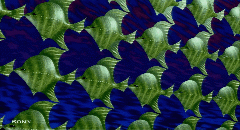
The American influence on Sonic went beyond the Green Hill Zone. When the idea of making a mascot game seized Sega in 1990, Nakayama declared they wanted "a product that will be a big hit in America!"[5] This unofficial marching order was a major influence on the design of the characters, the world they were building, and even the "roller coaster" design of gameplay.[33] An element of Sonic's personality was directly inspired by future president Bill Clinton. A rising star in the U.S. political landscape, his "get-it-done-now" attitude[4] seemed a perfect fit for the hedgehog. At one point, the team even contemplated using the tagline "number one hit in America"[34] to sell their new game. However, Sonic had not been designed to only succeed in the west. With the belief that a successful American property would automatically be attractive in Japan,[34] Ohshima was also designing the character with the Japanese audience in mind.[21] The game's designer, Yasuhara, was acutely aware of this dichotomy, wanting to build a game that would appeal both to the western gamer seeking a challenge, and the eastern gamer who was more interested in a casual experience.[35]
Sonic's first public appearance was at the ‘90 Tokyo Toy Show, where an extremely early demo was available for attendees. Through the rest of 1990, work on the game was behind closed doors, Sega of Japan instead promoting the upcoming title in other ways. In the November 1990[36] issue of Sega Players Enjoy Club, a brief "interview" with Sonic was published, establishing his attitude and his birthplace of Christmas Island. The feature also served as a way to introduce the musician behind the game, Dreams Come True's Masato Nakamura.
When it came time to find a composer for the game, Sega director Fujio Minegishi chose not to look inside the company, but instead offered to ask his contacts in the Japanese recording industry. At first, he suggested to the team the talents of Yuzo Kayama, who he was personal friends with.[15] While tempting, it was decided that his musical style wasn't the right fit for what they were going for. Instead, Masato Nakamura was offered the job. Given only conceptual artwork, the team behind Sonic explained how it was all meant to come together. Going off this information, Nakamura began to compose, wanting to treat the songs not as game music, but as a film score, hoping to tap into the success of such 80's movie soundtracks as Top Gun, Flashdance, and Dirty Dancing.[37]
| “ | I wanted 'Sonic' to come across as cinematic...I wanted melodies that the player would hum along with as they were playing, dramatic music for when the scenes were intense, climactic music for when bosses would show up, and then tie it all together with an uplifting theme for the end credits. That was what I knew I wanted it all to be like. | „ |
| — Masato Nakamura, Composer of Sonic the Hedgehog[38] | ||
Limited to the amount of sounds he could use at the same time, Nakamura found the process inspiring, forcing him "to be smarter"[39] in the way he wrote. The relationship between Nakamura and Sega continued into Dreams Come True's next tour, meant to promote their latest album, Wonder 3. Becoming one of their tour sponsors, Sega provided the band with a truck to carry their equipment in, which also had the image of Sonic plastered on the side.[38]
Production on the game continued. Expanding on Sonic's world, it was clear the hedgehog needed a main villain to go up against. One of Ohshima's discarded designs for the protagonist, the large mustached man, was repurposed to become the main antagonist of the game, his round shape also fitting the idea of keeping the characters simple enough for kids to draw.[40]. The villain, now named Dr. Eggman, helped set up a nature vs technology dynamic, tying into the era's growing popularity of environmentalism.[17] As the zone visuals continued to be refined, Sonic's shade of blue also had to be darkened so his sprites could stand out from the blues of Green Hill Zone's background.[41][25]
Approaching the level design, Yasuhara wanted to capture the feeling of an amusement park ride, that Sonic was leading the player on an experience that let them enjoy the world in a way Mario and other similar platformers were unable to.[17] Starting with quick sketches of gimmicks and obstacles, Yasuhara would consult with Naka, seeing what ideas should be prioritized, and which would be more difficult to program. However, some ideas that the team initially discarded were able to be reintroduced, such as the moving platforms in the jagged pathways of Scrap Brain Zone.[17]
File:SPEC JP 075.pdf The engine was meant to not only be the framework for a fun game, but also show off the technical capabilities of the hardware, though Naka felt the Mega Drive was not quite up to snuff with what he wanted to accomplish.[9] One of the main goals to help clearly separate the zones of Sonic from Mario was to step away from the blocky terrain that 8-bit platformers were built in. Developing a way to create smooth maps,[9] the task of creating working loops in Green Hill proved more difficult. When Sonic would try to run around the loop, his speed would cause him to break out of it completely.[9] Even if the sprite remained in the loop, the visual would look blocky, not at all like the smooth flow the team wanted to capture. When the problem was solved, Naka couldn't help but get excited.[42] Another early issue with the game was trying to find the right speed in which Sonic would run. Pushing the power of the system, Naka's first thought was to make Sonic go as fast as possible, but this proved to be an issue with those who would try out early builds, even Naka feeling motion sickness as he played the game.[35] Slowing down the character was the only solution.
With more of the game put together, Naka would invite people to come and play early versions, watching how they would handle Sonic the Hedgehog. Expecting people to take things slow, he was surprised that everyone would immediately run at full speed. He assumed that a first time player would take time to explore until they learned the levels, only going faster in subsequent playthroughs. However, no one who took a turn actually played it that way. These observations led to the creation of the ring system, which allowed even the most reckless player the ability to continue.[5] This also gave the team another excuse to show off the technical prowess of the Mega Drive, having the rings shoot out of Sonic in a visually dynamic display whenever he would get hit by an enemy.[14]
The core team would not always agree on how a level should be laid out. On more than one occasion, Naka or Ohshima would remove a difficult trap from a zone, thinking it was interrupting the flow of a level, only for Yasuhara to put it right back in. The back and forth was not one Ohshima begrudged, finding it an enjoyable experience that resulted in a balanced game.[43] Naka also found the dynamic unique, as it was the first time he felt that he was working as part of a team, as opposed to just carrying out the orders of a single person.[15]
By the time development was nearing its end, the small group within the employ of Sega CS R&D decided to call themselves "Sonic Team," after the project they had spent over a year working on. In May of 1991, during Japan's "Golden Week," the game was finally complete.[5] This first version was released in the United States on June 11th, 1991.[44] It would be a month until the game was for sale in Japan, the extra time allowing the team to polish a handful of bugs and add in some extra graphical effects.
After the game was complete, there was some consideration to release Sonic the Hedgehog to the Mega-CD. Though a single prototype was made,[45] it ultimately did not see release.
Westernization
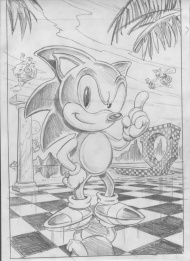
In early 1990, the head of the brand new Sega Technical Institute, Mark Cerny, was visiting Sega of Japan on business. While there, Naoto Ohshima, still working on potential designs for the mascot game, showed Cerny what he had come up with. Cerny, saying he was just "a random American,"[46] felt the opinions of Sega of America's marketing department would be better suited to give feedback on a character that was meant to appeal to western audiences. Making copies of the illustrations, he returned to the United States, handing them off.[46]
Sega of America's initial response was not positive. When CEO Michael Katz learned of Sonic's existence, he "thought it was nuts."[47] Having to ask what a hedgehog even was, he had little faith in the character, not knowing how to market a cartoon based on an animal no one in the United States had heard of. Quickly, he jotted down a top ten list of reasons Sonic the Hedgehog would fail,[48] sending the memo to Shinobu Toyoda, who was not only Executive Vice President of SOA but served as a conduit between SOA and Sega of Japan.[49]
Katz was not the only one initially confused by the character. Al Nilsen, Director of Marketing at SOA, was shown concept art of two different games the Japanese branch was working on.
| “ | "[Toyoda] opened this manila envelope and pulled out two drawings and the first one was kind of, very much Japanese animation derived and they were like these little eggs that were animated...and while I understood how they would work in the Japanese marketplace, in the US they would just come off as very preschool and so not something that would have broad appeal. The second one was a hedgehog." | „ |
| — Al Nilsen, Director of Marketing, Sega of America[49] | ||
The concept art had a fanged version of Sonic, complete with human girlfriend and a backing band. Asked which of the two concepts he thought would appeal to American gamers, Nilsen chose the "least of two evils," going with the hedgehog.[49]
Fearing the character "unsalvageable,"[46] SOA felt they needed to create their own concept for the perfect mascot. Looking to hire an outside designer, SOA were seeking to either hire Will Vinton, the designer of The California Raisins, or find someone who would be inspired by Vinton's style.[50] It was believed this individual could create something tailored to American sensibilities.[46] For unknown reasons, these plans quickly fell through.
A couple months after seeing the initial concept art, Al Nilsen found himself in Japan, visiting the Sega offices. It was there that, for the first time, he saw Sonic in action. Not yet at a point where the team felt comfortable with others playing, Al watched the character move on a black and white display, zipping along and rolling about. Shown the in-progress backgrounds separately, he finally saw the potential the game possessed. He just needed to play it himself to know for sure.[49]
Back at Sega of America, Michael Katz's time with the company was coming to an end. Unhappy with how things were going stateside, Hayao Nakayama reached out to former Mattel CEO Tom Kalinske, courting him to take over as CEO of Sega of America in July of 1990.[51] Unlike Katz, Kalinske's first impression of Sonic was relatively neutral. While he found certain aspects of the concept odd, he also knew that sometimes it was the wildest of ideas that would end up being successful.[52] He did agree with Al Nilsen and the Project Manager for Sonic the Hedgehog, Madeline Schroeder, that there needed to be some changes if the character was going to work stateside.
Returning to Japan, Kalinske gave a presentation to Nakayama and the board, getting into detail on how he felt they could best compete against Nintendo. At the center of this plan was Sonic. Having finally seen the game in action, he believed it had the chance to define the 16-bit era.[53] Kalinske told them that not only did the price of the Mega Drive (known as Genesis in America) need to drop, but that Sonic had to be packed in with the system. Once Kalinske's presentation was over, the members of the board started talking amongst themselves, clearly displeased with the proposal. Hayao Nakayama stood up, kicking aside his chair, and stormed towards the door, telling Kalinske that everyone thought his plan was crazy. Before leaving, he told Kalinske that he had hired him to do what he thought was best in America, and if his proposal was the way to go about it, to go ahead.[35]
It was during this time that Madeline Schroeder, whom those at SOA would refer to as "the mother of Sonic,"[35] went to work on best positioning Sonic for success. One of the first things she felt needed to change was the visual look of the character.[9] Hiring the creative agency Michael Patrick Partners, artist Greg Wray went to work softening the look of Sonic the Hedgehog, eventually drawing the image that would be on the front of every copy of the game sold in the U.S.[54] When Sonic Team learned of the redesign, they did little to hide their displeasure. Madeline Schroeder was forced to fly out to Japan and speak with the team herself, explaining that the changes were necessary if the game was going to succeed in the west. During the meeting, Sonic Team remained resolute in their dislike of the American redesign.[9] It was only later that the U.S. side of things was assured they could continue on as they saw fit.[49]
| “ | In those days, I hated the American change to the look and feel, and I didn't know how the consumers would perceive it. But looking back, that's one of the reasons that it succeeded. | „ |
| — Yuji Naka, Programmer and Project Manger of Sonic the Hedgehog[35] | ||
The look of Sonic was not the only factor the SOA team needed to consider. Tom Kalinske, during his time at Mattel, knew the importance of creating strong characters and building the fiction of the world around them, as he had done with the He-Man and the Masters of the Universe franchise.[52] Quickly, Madeline and Al began work on an internal "Sonic Bible," a document meant to explain Sonic's history and define the character's personality. The original draft[55] placed Sonic as a native of Hardly, Nebraska. Born "Sonny," the brown hedgehog ran into a kindly, if eccentric, scientist named Dr. Kintobor. Through a series of events, Sonic turned blue, was gifted his red and white sneakers, and Dr. Kintobor was accidentally transformed into the evil Dr. Robotnik. Further revisions[56] changed Sonic's home to the world of "Mobius." However, it wasn't the corporate team at SOA that came up with the name Robotnik.
Dean Sitton was both a Sega help line employee and a game tester. Being invited into meetings from time to time,[57] he had the chance to try out an early version of Sonic the Hedgehog. Afterwards, he was asked to submit potential names for both the robot enemies and the main antagonist of the game. For the latter, he put together a robust list. Dr. Robotnik[57] became the favorite, but others considered were Dr. Badvibes,[57] Doctor X, Doctor Gloom, Dr. What,[58] and Nasty McRotten.[59] Sitton also came up with the first name, Ivo, wanting it pronounced with a soft "I" to make it closer to the word "evil."[60] A handful of badnik names, including Ball Hog, Caterkiller, and Buzz Bomber[61] were suggested by Sitton as well.
With the pieces falling into place, newer builds of the game were sent over stateside, the employees of STI even fighting over who would be able to play during downtime.[62] Al Nilsen was happy that attitude was now taking precedence over aggressiveness,[49] even the idle animation of Sonic tapping his foot tying into how they wanted to market Sonic.[63] He was sure the game would be a hit, but Tom Kalinske wanted some sort of empirical evidence to seal the deal. With an imported copy of Super Mario World, Al Nilsen went around the country, gathering secret focus groups to try out both World and Sonic the Hedgehog. The results were clear - eighty percent of those who tried both preferred Sonic.[49]
Sonic the Hedgehog would make its first public appearance in the United States during the Winter Consumer Electronics Show in January, 1991.[64] This wouldn't be treated as Sonic's official coming out party, as Sega of America wanted to keep the game a relative secret[9] until the Super Nintendo was officially showed off in the west. The time came at Summer CES 1991, where the SNES and its lineup of games were revealed to the press. After Nintendo's presentation, the show floor was open, the Sega booth doing something unexpected - having both Mario and Sonic playing side by side.
| “ | The doors to CES opened, and about two minutes after that a reporter...came up to me and said "Super Nintendo has 32,768 colors. You've only got 512. What are you going to do about it?" So silently I just motioned for him to follow me, and walked over to a place in our booth where we had two large tv monitors. One had Sonic the Hedgehog, and one had the new 16-bit Super Mario. And I said "which one has more colors? It's not how many colors you have, it's what you do with them." Immediately, he saw the difference. | „ |
| — Al Nilsen, Director of Marketing, Sega of America[9] | ||
This direct comparison between the two games continued in both a mall tour[51] and television advertising.[65]
By September 15th, 1991, the Sega Genesis was being sold exclusively with Sonic the Hedgehog as the pack-in title, those who had purchased the system between July and September able to get a free copy of the game.[66] The move had paid off, and after the Christmas season, the Sega Genesis had overtaken the Super Nintendo with an estimated 57.8 percent of the market share.[67]
Fictional character origin
While developing Sonic the Hedgehog as a character, Sonic Team was acutely aware of what elements they wanted him to embody. Among those elements was a sense of history and nostalgia. Looking at characters from successful brands such as Disney, Marvel, and Sanrio, what seemed to be true across all of them was history and familiarity. Icons that not only stood the test of time, but seemed like they had always existed, and had a fleshed out world for their stories to be told in.[17]
As Sonic was being built from the ground up, there was no built in history for the character. Instead, the team began exploring the idea of a "fictional history" for Sonic, not just in-universe but also in the real world. At the time, Naoto Ohshima had a keen interest in leather jackets, emblems, and airplane nose art. Coincidentally, the era from when airplane nose art was at its height was the same era in which Sega first came into being, back when it was Service Games. Working with Ohshima, Hirokazu Yasuhara ended up writing a backstory for the character that tied into that same historical period.[17]
The story begins in 1947 America, where an unnamed fighter pilot was nicknamed "hedgehog," due to the way his hair would stand up on end when he took off his flight helmet. His wife, Marie Granette, who was an author of children's books, was inspired to create a character based on her husband's nickname. Calling this character "Sonic," she would also tell these stories to their daughter. Designing a blue hedgehog, it ended up on the back of the pilot's leather jacket, the story of the hedgehog spreading even if no one could recall the pilot's name.
On one fateful day, two test pilots took part in an experiment - to be the first human able to break the speed of sound. While Chuck Yeager successfully crossed that barrier with no problem, the man known as "hedgehog" unfortunately did not, his plane exploding the moment he hit the speed of sound.
Jumping ahead to the 1980's, a freelance photographer named Meg happened to find a leather jacket with an image of Sonic the Hedgehog on the back. Recognizing the character from stories she heard as a child, she purchased the jacket, wearing it to work. While photographing an air show, an accident occurred overhead, causing one of the planes to crash. Rushing to cover this breaking story, a second plane crashed next to her, trapping Meg in a circle of flames. Suddenly, a gloved hand reached out, rushing her to safety as she lost consciousness. Waking up in a hospital bed, she could only guess what had happened, the charred jacket no longer having Sonic. When developing the photos she took on the day of the accident, she was shocked to see a familiar pair of red shoes in one of the shots.
The story would be adapted in the third volume of Sonic the Hedgehog Story Comic as a prose piece, with some details changed. The original text would not be shown to the public until Sonic Jam Official Guide was published in Japan, showcasing all three episodes.[68] The first episode would later be reprinted in both Japanese and English in the Sonic Adventure 2 Birthday Pack history book.[69]
Logo design
The distinctive "ribbon, ring, and stars"-styled title screen used in the first Sonic the Hedgehog and subsequent installments was something of a theme in early Sega games. While difficult to prove, inspiration likely came from the title screen from the 1988 Sega arcade game Wonder Boy III: Monster Lair, which bears similarities to that of the 1986 Sega arcade game Alex Kidd: The Lost Stars.
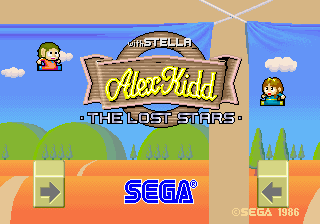
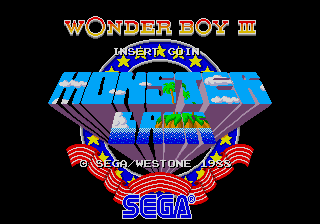
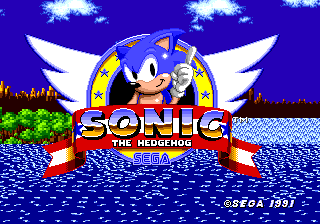
The addition of "wings" hearkens back to Ohshima's interest in aviation emblems,[17] being a feature of medals awarded to American air force service personnel since the second World War.
The "SONIC" text is attempting to emulate the "chrome" design seen across numerous logos across the 1980s and early 1990s (including the Mega Drive console itself). This trend is usually attributed to the 1979 film, Mad Max.
Concept art
Twin Stars proposal
In 1989,[70] Naoto Ohshima began conceptual work on a game with the working title Twin Stars.[7] The premise of the game featured a pair of twin brothers from the Dream World defending it against the boss of the Nightmare World, "Thirteen."[7] An action game with smooth terrain, it was also to feature loops that the characters would run through. While the gameplay concept was approved by Ohshima's superiors, the characters were not,[8] leaving Ohshima to come up with a new protagonist.[71] The concept of a Nightmare World and Thirteen would continue to exist as a temporary enemy after Sonic the Hedgehog was created until the world of Sonic was further developed.[72]
The unnamed protagonists of Twin Stars, in front of a tropical, loop-covered area. The fanged visage of Thirteen hangs above.[7]
The twin brothers, along with a number of enemy concepts. Some of these would be reused once development began on Sonic the Hedgehog.[7]
Pages 1 through 12 of the original design document, with the working title Twins Special.[73]
Pages 13 through 22.[73]
A close-up of page 15, showing a possible title screen concept.[74]
A close-up of page 17.[74]
Page 22 of the design document, machine translated into English.[75]
Character concept art
Unused character art
The following is a collection of images drawn by a variety of Sega employees during the internal competition to create a new mascot for the company. The majority of these images come from the Sonic History Video, a promotional VHS tape made available to those who preordered Sonic the Hedgehog 3 in Japan.
The original rabbit design by Ohshima. This character would be playable in the earliest test builds of the game.[76]
A slightly cleaned up version.[77]
A different rabbit design, sporting a full outfit with belt and sneakers.[78]
Colored version.[77]
Bulldog character. By Ohshima.[77]
Human character with Bart Simpson-like hair. By Ohshima.[77]
An animal of some sort in clothing. By Yasushi Yamaguchi.[77]
An elder warrior ready for battle. By Yamaguchi.[77]
Two additional outfits for the elder. By Yamaguchi.[77]
Clown and a young warrior wearing head of a animal.[77]
Assorted designs, including a robot character.[77]
A collection of doodles.[77]
A small porcupine.[77]
Chicken with an attitude.[77]
Sonic the Hedgehog & Dr. Eggman
An alternate angle of the four early doodles.[79]
Comparison between Ohshima's early Sonic sketch and a hedgehog design by Yasushi Yamaguchi.
It was coincidence that Ohshima and Yamaguchi had come up with the idea of making a hedgehog character.[77]
Artwork of Sonic the Hedgehog intended for promotional use at the ‘90 Tokyo Toy Show.[16]
An early sketch of Sonic.[80] It was eventually cleaned up and featured on the Japanese and European box art.
Color Sheet.[81]
Flyer Concept "plan 2."[82] The headline says "ill weeds grow apace".
Letterhead Concept.[83] The headline says "let's throw away crappy games and love that has vanished in tears".
A rough draft of Sonic's victory pose at the end of Sonic the Hedgehog.[84]
A humorous doodle drawn during Sonic the Hedgehog's development in 1990.[85]
Art of Sonic illustrating his run cycle and speed. "In the old days, I used to sketch all animation patterns and draw dots."[86]
Physical 3D model of Sonic used as a reference for animators. It was also the basis for the Sonic CD title screen. Sculpted by Taku Makino[87]
Lineart of Sonic the Hedgehog, intended for promotional material.[88]
Original illustrations used for the Mega Drive precautions in the Japanese manual.[89]
Madonna & unnamed enemies
Among the original concept of Sonic the Hedgehog was a character named Madonna. Inspired in part by the singer of the same name,[90] she was intended to be a love interest for Sonic. When Naoto Ohshima first showed off Sonic’s design, many of his colleagues thought that the character was "cute" and "a child," but in Ohshima’s mind Sonic was a bit older and mature.[9] To make this clearer, he created an adult woman in a red dress who would be his girlfriend.[21] She was meant to be "like a male fantasy," chasing the hedgehog about.[35] Whether or not she was meant to literally follow him in the game at any point is unknown, though it is likely she was to chase him only in promotional material.
Sega of America's project manager for Sonic, Madeline Schroeder, stated that she was responsible for the removal of the character in an attempt to make the game an easier sell in western markets[35]. However, this was later contradicted by Yuji Naka during an interview at Summer of Sonic 2011. When recalling the development process, Naka explained that Madonna never went beyond the concept stage primarily due to the stark comparison her presence would have made between Sonic and the Super Mario Bros. series. Having a heroine who would be kidnapped and subsequently rescued by the hero of the game had become a cliché, and the team decided they should focus on Sonic just fighting the main villain.[91]
One of the initial pieces of concept art featuring Madonna also included a variety of potential enemies Sonic would be forced to fight. When responding to an email from a fan, Naoto Oshima stated:
| “ | Thanks for your mail. I drew that. Why is the boss of that drawing a monster? Is that a fantasy world? The world in the drawing is a nightmare world. Since I've got nothing to do, I'll write the reason on Twitter. This was Sonic's original concept before it became what it is now. | „ |
In the first ever public demo of Sonic the Hedgehog, a large-jawed enemy was visible, technically being the first sprite Sonic ever had to face off against. As the concept for Sonic was refined, this enemy was completely removed. In the end, the only antagonist that survived was the bumblebee-clad man, who would eventually become Dr. Eggman.
Sonic the Hedgehog Band
During the development process, Sonic was at one point meant to front a musical group, serving as lead singer. The other members of the band were Max the Monkey on bass guitar, Mach the Rabbit on drums, Sharps the Parakeet on lead guitar, and Vector the Crocodile on keyboards. In storyboards that were part of the original Sonic the Hedgehog design document,[93] the various members of the band were meant to be a part of the story, needing rescue by Sonic after having been captured by Dr. Eggman. They were also meant to bookend the game, featured not only in the ending but also seen when the Sega logo appeared.
Though it is currently unknown if they were ever realized in an early prototype of the main game, the band was also planned to be used in a separate sound test screen. Wanting to do something special for the music, an elaborate animated sequence was conceived, featuring Sonic the Hedgehog moonwalking and breakdancing along to the music his band would perform.[94]
Two disparate accounts exist regarding why the band was completely removed. Madeline Schroeder, among others, have stated that it was a decision from Sega of America to cut the band from Sonic, in their effort to soften the character and his world for an American audience.[35] However, Yuji Naka claimed that the reason for the band's removal was far more benign, an unfortunate victim of time constraints. With the sound test relegated to the hidden level select, the freed up memory in the program was instead used to house the "SEGA" chime that was used in Japanese advertisements of the time. The sound clip ended up using an eighth of the cartridge space.[94] Naka would later say his epiphany to use the sound was "a very good decision."[95]
Removed from the final product, the band characters would be used in a limited capacity for promotion of the game, including a handful of color illustrations and a cameo appearance in the first volume[96] of Sonic the Hedgehog Story Comic. While a character similar to Sharps named Max the Parrot[97] would be conceptualized in 1992,[98] Vector would end up being the only character from the band to become a member of the game cast.
The visual of Sonic holding a microphone was featured in the credits of the 8-bit version of Sonic the Hedgehog, though it is unknown if the sprite art used was based on any sprite intended for the removed 16-bit sound test, or simply inspired by concept art.
Game concept art
Naoto Ohshima
Levels
The following is a collection of images drawn by Naoto Ohshima during the production of Sonic the Hedgehog's Zone creation process. It is possible that two of these pieces are meant to represent the unmade levels "Gold World" and "Chinese World."[43]
Translation: "1. Metallic stage... A gleaming, gold plated landscape with a Southeast Asian feel."[99]
Alternate scan. This image would inspire the loops present in Golden Capital Zone, from Sonic Superstars'.
Concept art of an early Green Hill Zone. Translation: "2. CG style stage... The background consists of a blue sky and green hills, rendered in a CG style never seen before."[99]
Concept art showing multiple paths, using a move that isn’t in the final game. Translation: "3. Sonic mountain/underwater stage ... Japanese style rocky hills with underwater sections. The illustration shows how the character can spin to move across the surface of the water. There will be various courses to choose from, dependent on skill."[100]
Concept art of a Marble Zone-esque area. Translation: "Quaking landform stage... The ground is made from a primordial material which shakes and trembles. The character can burrow through the landscape."[100]
A conceptual Spring Yard Zone, complete with the unused hand enemy, using its original name Sparkling Zone.[101]
Concept art of Labyrinth Zone.[102]
Concept art marked as belonging to Star Light Zone.
Rough translation: "5. space themed stage ..... your jump height will increase. in the image there is a two player mode in the concept."[103]
Rough translation: "6. Great spirit world themed stage ..... based off of china like place."[104]
Rough translation: "7. Laboratory instrument like stage .....placing the pipe to spin through it."[105]
Concept art of a Scrap Brain Zone-esque area. Rough translation: "8. Megalopolis stage ..... going through tricky gimmicks to advance."[106]
Animated Sequences
The following is a collection of conceptual storyboards for various animated sequences and cutscenes drawn by Naoto Ohshima in 1990.
An unused "SEGA" sequence which featured members of Sonic's Band.[93]
The title screen, lowering from above.[93]
Concept art for the Continue screen, Game Over screen, and a cut item collection mechanic.[93]
Concept Art for a Mid Boss, Zone Clear sequence, and Stage Clear sequence. The Mid Boss seen here would be further developed into the Green Hill Zone boss.[93]
Concept art for the final boss. Elements of this concept may have been implemented at one point in the 8-bit version, evidenced by left over turret sprites in the Master System version.[107]
Storyboards for the original ending sequence.[107]
Storyboards for the original ending sequence. The concept of Sonic falling from the sky and being saved mid-air would be reused in the ending of Sonic the Hedgehog 2.[107]
Storyboards for the original ending sequence. The only surviving element is Sonic's victory pose.[107]
Enemies
The following are early drawings of various Badniks in Sonic the Hedgehog.
Nal, featuring two more body segments than the final version.
Hirokazu Yasuhara sketches
Hirokazu Yasuhara was the lead game designer on Sonic the Hedgehog. Below are a number of his sketches showcasing layout and zone obstacles, some of which would not make it into the final version of the game.
Zone 1 Map Idea 002.[108]
Zone 1 Map Idea 005, Part 1. "Speed and height are good friends."[109]
Zone 1 Map Idea 005, Part 2. "Springs carry you to hidden paths."[110]
Zone 1 Map Idea 005, Part 3.[33]
Further concept sketches of the spring gimmick.[111]
"This is also a gimmick which related with water."[112]
"This was an idea for water-level. Character has to prepare floating platform in a certain time."[113]
"Bottomless swamp makes the character slow down. Player has to tap jump button rapidly to let him escape from there."[114]
Concept for opening alternate paths with bombs. "This idea didn't adopt for the game. Because Sonic runs too fast to see this sort of gimmicks."[115]
"I'd been looking for the reason why player has to let the hero perform 'rolling.'"[116]
"Level Environment would be also changed its behavior by the difference of character-form."[117]
Map of Green Hill Zone Act 1.[118]
'90 Tokyo Toy Show
Sonic the Hedgehog demo
Sonic the Hedgehog was officially revealed to the world at the '90 Tokyo Toy Show which took place during the second week of June, 1990. Shown off early in the development process, not even the loops of Green Hill Zone existed, Sonic only able to "run at high speed on a slightly wavy track."[16] As so little was done at the time, the team wanted to try and "bluff" their way through the demo,[16] making the game look far more polished than it actually was. The draw was the seven layers of parallax scrolling, with trees and rock formations in the foreground moving independently from clouds and other objects in the background.
Lacking a promotional budget for the show, Naoto Ohshima ended up making a number of signs and posters by hand, having them set up in and around Sega's booth.[16]
Years later, during the development of Sonic Mega Collection, Naka wanted to include this specific prototype in the game compilation.[119] Unfortunately, he was unable to find the ROM in Sonic Team's archives.
Title screen
An explosion effect, appearing during the Sega logo.[120]
Another frame, the Sega logo visible.[120]
The title screen from the Tokyo Toy Show demo. Similar to the final, it lacks a background, making it appear more like the 8-bit version of the game.[120]
Green Hill Zone
The likely starting point of the stage. A blue structure is noticeable in the background, missing from the final game.[120]
The same location, but with the clouds in a different position, implying automatic scrolling.[121]
Walking along.[122]
Sonic faces an enemy as it jumps over him.[120]
Sonic jumping, uncurled, over another unnamed enemy.[122]
Sonic nearly goes off scren.[120]
A sign known only to exist in this build. It says "You Are Welcome" and "Never Open."[120]
A message in Japanese appears over Sonic. Translates to "debut approaching".[120]
A close up of the unnamed enemy. Facing towards the right, it possibly turned to look at Sonic, who avoided it.[120]
Other
The game on display at the show, visible in the column of monitors second from left.[124]
Rotation tech demo
Separately at the Tokyo Toy Show, Sega had a brief technical demonstration of the Mega Drive hardware, showing real-time rotation and scaling. The graphics used in the demo featured various Sega properties, including Alex Kidd, Phantasy Star and the brand new Sonic the Hedgehog. In the demo, a single image of Sonic, Madonna and the game's logo is shown scaling in real time over a background of Sega logos. A sped-up version of the Green Hill Zone music is played during the sequence[125].
Winter Consumer Electronics Show 1991
On March 12, 1991, an episode of Computer Chronicles[126] focused on the 1991 Winter Consumer Electronics Show. The show happened to include footage of an early build of Sonic the Hedgehog, which was playable on the show floor. Numerous differences from the final game can be seen even in the short glimpse of Green Hill Zone. Among that which is noticeable are the flowers in the level being purple instead of green, the word "RING" instead of "RINGS" in the HUD, and the brief appearance of an Eggman monitor which goes unused in the final game.
The monitors seen in this footage[127] seem to be cycling through different power-up icons - in the footage available, the first monitor which appears can be seen to change between an Eggman icon and a Sonic icon, and the second monitor cycles through the first and second frames of static, and finally to the Eggman icon just as it disappears off-screen. Each frame seems to be displayed for around half a second before changing to the next in sequence - as the player doesn't break either monitor, it's unknown whether the effect of the monitor was intended to be dependent on which icon was displayed when it was broken, or if the programming for the monitors had yet to be finalized and this was simply a test routine for displaying the various different power-up icons.
There are also examples of an earlier Ball Hog enemy that attacks in a similar fashion to the Crabmeat found in the final version of the Green Hill Zone, throwing a projectile on either side as opposed to the single shot they fire in Scrap Brain Zone. Concept art for this variation of the Ball Hog can be seen within the Japanese Sonic the Hedgehog manual[128]. Coding for this Ball Hog exists within the dumped prototype, where it drops projectiles directly downward.
Also of note is that a form of the debug mode is active in the clips, the numbers in the lower right hand corner corresponding to debug values. Sonic's position is represented differently by the debug mode in the final game.
While visually the Green Hill Zone is slightly different from the final version of the level, elements such as the purple flowers and the strikingly close shades of blue in the background did make their way in the finished version. The flowers make an appearance in the ending sequence, while the original Green Hill Zone background appears on the title screen.
Promotional screenshots
The following is a collection of images published in a variety of sources used to advertise Sonic the Hedgehog and to comment on its progress. Many of these screenshots can be sourced from the dumped prototype, though a few screenshots may have come from earlier/later builds before the final release.
CES-like builds
Title screen
An early level select. The zones are placed in their original order. Final Zone is not listed and Xs are listed after some levels. The "Press Start Button" text is also visible.[133]
Green Hill Zone
After being hit, Sonic gets knocked back more than in final.[131]
In the final game, every loop in Green Hill Zone has a monitor on top. This one doesn't.[134]
Marble Zone
An early Marble Zone featuring graphical work not seen in the final game. Possibly a mock-up.[135]
A newer build, now with red UFOs adorning the sky.[136]
Alternative scan.[137]
Different lava graphics from final, but final debug mode HUD position.[133]
The green pillars haven't been installed in this early build. The background torch is also not lit and the lava graphics are different.[133]
This different build sees the addition of the pillars, but the torch is still unlit.[132]
The infamous "sideways spikes." They were replaced with moving blocks in the final game. The code and graphics for these objects still exist within the final release, but are unused. The background torch is still unlit.[131]
Sparkling Zone
Start of Act 1.[138]
Labyrinth Zone
A blue background. This might be before a background was implemented into the zone.[133]
Clock Work Zone
Special Stage
Early Special Stage screenshots feature a layout not seen in the final game. All the bricks are yellow and there appears to be no objects.[140]
The fish background.[142]
Screenshots in Mega Drive Fan suggest the stage rotates clockwise. (1)[142]
(2)[142]
(3)[142]
(4)[142]
A screenshot printed on the Mega Drive Brazilian box, distributed by Tectoy.
Dumped prototype
These screenshots line up with the dumped prototype:
"Official" screenshots
These screenshots were produced by Sega themselves for promotional material:
Title screen
"Press Start Button" text on-screen.[146]
Green Hill Zone
Act 1
Debug mode, with the player transformed into a ring.
Alternative scan[151].
More spikes here than in the final game.[152]
A tunnel.[155]
Sonic posing as he jumps, an early end level celebration.[155]
A prototype map.[156]
Another map, complete with rolling ball.[157]
The layout is otherwise identical to the final game.[158]
Act 2
Act 3
A loop, now with a monitor on top.[138]
This shield monitor is not here in final.[157]
Eggman turns up.[159]
Marble Zone
Footage of the UFOs rotating can be seen in the film Wayne's World during a promotion for "Noah's Arcade." Early lava graphics can also be made out.[162]
More UFOs and Spikes Badnik.[156]
A stitched-together map.[158]
The first switch of Act 2 is missing on the right hand side. While it is possible to trigger Sonic's balancing animations here in the final game, Sonic will be positioned a few more pixels to the left.[164]
A lit background torch, but a room that doesn't exist in the final game.[165]
Finishing Act 1. The left of Sonic's punching the air sprite can be seen.[159]
Sparkling Zone
The sign on the right says "GOGO".[166]
The giant set of rotating spikes.[167]
More of the background.[166]
A heavily edited screenshot containing signs found in this early build.[156]
Some odd ring placements.[158]
Labyrinth Zone
Water has yet to be placed on this slide.[148]
Early background is clearly visible.[152]
Background is missing.[148]
Star Light Zone
Star Light Act 1.[165]
Debug mode appears to be active.[156]
A small map, showing one of the loops.[170]
Clock Work Zone
Alternative screenshot.[148]
Diagonal conveyor belts.[148]
Diagonal belts again.[170]
Tile placement is unfinished.[150]
The zig-zag tunnel.[166]
Sonic emerges from a tunnel.[163]
Special Stage
Late RING builds and Early RINGS builds
The checkered ball is still present, but sunflowers are now green.[178].
Spikes still visibly implemented in a late build of Spring Yard.[179]
The top row of springs here are missing in final.[180]
References
- ↑ "Big discovery! ! Sonic the Hedgehog initial development site.Sega R&D news footage of February 1990. Sonic's ground collision is shown on the screen. This is 24 years old Yuji Naka.", @nakayuji on Twitter (Wayback Machine: 2018-06-24 09:49)
- ↑ @nakayuji on Twitter (Wayback Machine: 2021-10-15 04:15)
- ↑ "Though it was a more powerful unit, Sega's Master System, marketed as the Mark III in Japan, had not fared well in that country, where Nintendo controlled more than 90 percent of the market.", File:UltimateHistoryofVideoGames Book US.pdf, page 320
- ↑ 4.0 4.1 4.2 4.3 4.4 4.5 4.6 File:SonicAVeryQuickHistory GameTap Video Part1.mp4
- ↑ 5.0 5.1 5.2 5.3 5.4 5.5 5.6 http://shmuplations.com/sonic/ (Wayback Machine: 2020-12-18 10:54)
- ↑ 6.0 6.1 6.2 [The History of Sonic the Hedgehog, Pix'N Love, page 97 The History of Sonic the Hedgehog, Pix'N Love, page 97]
- ↑ 7.0 7.1 7.2 7.3 7.4 @NaotoOhshima on Twitter (Wayback Machine: 2023-01-21 17:39)
- ↑ 8.0 8.1 @NaotoOhshima on Twitter (Wayback Machine: 2023-01-22 05:34)
- ↑ 9.00 9.01 9.02 9.03 9.04 9.05 9.06 9.07 9.08 9.09 9.10 File:HistoryofSonicTheBirthofanIcon Video.mp4
- ↑ 10.0 10.1 https://www.youtube.com/watch?v=fHkosWFNRko
- ↑ [Sega Mega Drive/Genesis: Collected Works, page 278 Sega Mega Drive/Genesis: Collected Works, page 278]
- ↑ [Sega Mega Drive/Genesis: Collected Works, page 308 Sega Mega Drive/Genesis: Collected Works, page 308]
- ↑ File:NintendoPower US 211.pdf, page 70
- ↑ 14.0 14.1 14.2 http://www.gamasutra.com/view/feature/132163/game_design_psychology_the_full_.php?page=5 (Wayback Machine: 2018-11-18 22:23)
- ↑ 15.0 15.1 15.2 15.3 http://shmuplations.com/sonicteam/ (Wayback Machine: 2020-12-15 23:41)
- ↑ 16.0 16.1 16.2 16.3 16.4 16.5 16.6 16.7 16.8 https://www.famitsu.com/news/201606/24107383.html (Wayback Machine: 2016-06-25 12:35)
- ↑ 17.00 17.01 17.02 17.03 17.04 17.05 17.06 17.07 17.08 17.09 17.10 17.11 https://www.gdcvault.com/play/1024928/Classic-Game-Postmortem-Sonic-the
- ↑ ""I recently found the second draft of the proposal for Sonic. This was created by myself and Hayashida (Kotaro, who was then chief of the planning section). For the first draft, the main characters were called Twin Star, a pair of boys who fought against nightmares. In the second draft, there are remnants of the word 'nightmare.' After that, I joined with Yuji Naka, and the character became the hedgehog called Sonic."", Beep21 https://forums.sonicretro.org/index.php?threads/naoto-ohshima-twin-star-wonder-hedgehog-1990-tokyo-toy-show-and-other-goodness.40767/ Beep21 (Wayback Machine: 2022-04-27 23:15)
- ↑ [The History of Sonic the Hedgehog, Pix'N Love, page 98 The History of Sonic the Hedgehog, Pix'N Love, page 98]
- ↑ 20.0 20.1 [Sega Mega Drive/Genesis: Collected Works, page 328 Sega Mega Drive/Genesis: Collected Works, page 328]
- ↑ 21.0 21.1 21.2 [The History of Sonic the Hedgehog, Pix'N Love, page 99 The History of Sonic the Hedgehog, Pix'N Love, page 99]
- ↑ @NaotoOhshima on Twitter (Wayback Machine: 2020-01-29 07:59)
- ↑ "これは最初のテスト制作したぬいぐるみです。 1点物。彼は立っている。1990年物。It is a stuffed toy for the first test. 1 point thing. He is standing.1990 thing.", @NaotoOhshima on Twitter (Wayback Machine: 2020-01-29 07:59)
- ↑ http://www.sega-16.com/2007/06/developers-den-sega-technical-institute/ (Wayback Machine: 2016-08-05 18:17)
- ↑ 25.0 25.1 25.2 [The History of Sonic the Hedgehog, Pix'N Love, page 92 The History of Sonic the Hedgehog, Pix'N Love, page 92]
- ↑ [Retro Gamer, issue 100, page 48 Retro Gamer, issue 100, page 48]
- ↑ https://youtu.be/O9AZ9CGMi4k?si=9PvVJj-9dxshHmZe&t=305
- ↑ https://youtu.be/YW26YMe8iUQ?si=GqfLnJncYJZmpeDU&t=104
- ↑ File:SonysMetamorphosis 1990 specialstage.gif
- ↑ https://www.destructoid.com/stories/a-chat-with-sega-s-first-lady-of-rpgs-rieko-kodama-532348.phtml (Wayback Machine: 2020-08-09 11:19)
- ↑ File:Megadrive Fan 1991-07.pdf, page 75
- ↑ https://forums.sonicretro.org/index.php?threads/jina-ishiwatari-tsukaharas-largely-unrecognized-contribution-to-sonic.41246/ (Wayback Machine: 2022-08-23 03:22)
- ↑ 33.0 33.1 [High Score Episode 4: "This is War" High Score Episode 4: "This is War"]
- ↑ 34.0 34.1 [The History of Sonic the Hedgehog, Pix'N Love, page 94 The History of Sonic the Hedgehog, Pix'N Love, page 94]
- ↑ 35.0 35.1 35.2 35.3 35.4 35.5 35.6 35.7 File:SonicAVeryQuickHistory GameTap Video Part2.mp4
- ↑ File:SPEC_JP_07.pdf, page 76
- ↑ File:Sonic1&2Soundtrack JP Booklet.pdf, page 8
- ↑ 38.0 38.1 https://www.sega.com/sonic/globalsonic/post_sonicteam.php?article=nakamura (Wayback Machine: 2008-12-23 02:29)
- ↑ File:Sonic1&2Soundtrack JP Booklet.pdf, page 10
- ↑ http://www.sega.com/features/allsonic/creator/naka04.html (Wayback Machine: 1996-12-20 02:04)
- ↑ "One much smaller Sonic inside story: the character’s color was changed just prior to release. Sonic had been a lighter blue, but he was very hard to see against the ocean backgrounds, so his color was darkened at the last moment.", https://www.sega-16.com/2006/12/interview-mark-cerny/ (Wayback Machine: 2014-10-17 13:07)
- ↑ [The History of Sonic the Hedgehog, Pix'N Love, page 91 The History of Sonic the Hedgehog, Pix'N Love, page 91]
- ↑ 43.0 43.1 [Sega Mega Drive/Genesis: Collected Works, page 329 Sega Mega Drive/Genesis: Collected Works, page 329]
- ↑ [vgce, issue 29, page 32 vgce, issue 29, page 32]
- ↑ http://www.sega.co.jp/nights/sonic/esonic.html (Wayback Machine: 1997-02-15 17:27)
- ↑ 46.0 46.1 46.2 46.3 https://segaretro.org/Interview:_Mark_Cerny_(2006-12-05)_by_Sega-16
- ↑ https://segaretro.org/Interview:_Michael_Katz_(2006-04-28)_by_Sega-16
- ↑ https://www.youtube.com/watch?v=juoaAoXz1AU
- ↑ 49.0 49.1 49.2 49.3 49.4 49.5 49.6 https://www.youtube.com/watch?v=JxrvZK3mUcE
- ↑ https://www.timeextension.com/features/playstation-5-lead-architect-mark-cerny-talks-sega-michael-jackson-and-yuji-naka (Wayback Machine: 2023-01-26 16:06)
- ↑ 51.0 51.1 [Console Wars, CBS All Access Console Wars, CBS All Access]
- ↑ 52.0 52.1 https://www.youtube.com/watch?v=73abjrBD3NU
- ↑ [Sega Mega Drive/Genesis: Collected Works, page 23 Sega Mega Drive/Genesis: Collected Works, page 23]
- ↑ https://michaelpatrickpartners.com/identity-design-sonic-the-hedgehog (Wayback Machine: 2018-03-14 01:56)
- ↑ File:SonicBible Document.pdf
- ↑ File:SonicBibleDraft1 Document.pdf
- ↑ 57.0 57.1 57.2 https://forums.sonicretro.org/index.php?posts/115309
- ↑ https://forums.sonicretro.org/index.php?posts/268696/
- ↑ https://forums.sonicretro.org/index.php?threads/deansatan-enters-the-fray.13659/page-6#post-268804 (Wayback Machine: 2024-02-05 06:47)
- ↑ https://forums.sonicretro.org/index.php?posts/268012/
- ↑ https://forums.sonicretro.org/index.php?posts/267965/
- ↑ [Sega Mega Drive/Genesis: Collected Works, page 21 Sega Mega Drive/Genesis: Collected Works, page 21]
- ↑ [[9] [9]]
- ↑ [cvg, issue 112, page 11 cvg, issue 112, page 11]
- ↑ https://www.youtube.com/watch?v=mK0OFsWWzu4
- ↑ [Console Wars: Sega, Nintendo, and the Battle That Defined a Generation, Blake J. Harris, page 150 Console Wars: Sega, Nintendo, and the Battle That Defined a Generation, Blake J. Harris, page 150]
- ↑ [Marinucci, Carla (1992-01-12). "Sega shows Nintendo it knows how to play, too." San Francisco Examiner, B1 Marinucci, Carla (1992-01-12). "Sega shows Nintendo it knows how to play, too." San Francisco Examiner, B1]
- ↑ File:SonicJamOfficialGuide_Book_JP.pdf, page 7
- ↑ File:SonicAdventure2_DC_JP_historybook.pdf, page 13
- ↑ @NaotoOhshima on Twitter (Wayback Machine: 2023-01-22 06:17)
- ↑ @NaotoOhshima on Twitter (Wayback Machine: 2023-01-21 23:14)
- ↑ @NaotoOhshima on Twitter (Wayback Machine: 2023-01-22 05:57)
- ↑ 73.0 73.1 @tetsu_skytree on Twitter (Wayback Machine: 2023-01-23 23:23)
- ↑ 74.0 74.1 @tetsu_skytree on Twitter (Wayback Machine: 2023-01-21 23:01)
- ↑ https://ghostarchive.org/archive/fQGY7
- ↑ @NaotoOhshima on Twitter (Wayback Machine: 2023-01-21 23:39)
- ↑ 77.00 77.01 77.02 77.03 77.04 77.05 77.06 77.07 77.08 77.09 77.10 77.11 77.12 https://www.youtube.com/watch?v=N_25hXDmbyc
- ↑ [The Blue Blur: Origins of Sonic The Blue Blur: Origins of Sonic]
- ↑ https://archive.org/details/bad_influence_se1ep4
- ↑ @NaotoOhshima on Twitter (Wayback Machine: 2021-01-18 03:04)
- ↑ @NaotoOhshima on Twitter (Wayback Machine: 2021-01-18 03:19)
- ↑ @NaotoOhshima on Twitter (Wayback Machine: 2021-01-24 23:59)
- ↑ @NaotoOhshima on Twitter (Wayback Machine: 2020-05-30 04:05)
- ↑ @NaotoOhshima on Twitter (Wayback Machine: 2021-01-18 03:15)
- ↑ @NaotoOhshima on Twitter (Wayback Machine: 2021-01-18 03:09)
- ↑ @NaotoOhshima on Twitter (Wayback Machine: 2021-01-18 05:16)
- ↑ @NaotoOhshima on Twitter (Wayback Machine: 2018-05-18 22:34)
- ↑ @NaotoOhshima on Twitter (Wayback Machine: 2021-01-18 05:20)
- ↑ @NaotoOhshima on Twitter (Wayback Machine: 2021-01-18 05:22)
- ↑ [Sega Mega Drive/Genesis: Collected Works, Page 155 Sega Mega Drive/Genesis: Collected Works, Page 155]
- ↑ https://www.youtube.com/watch?v=a9B8Isv7EY0
- ↑ [ ]
- ↑ 93.0 93.1 93.2 93.3 93.4 [Sega Mega Drive/Genesis: Collected Works, Page 182 Sega Mega Drive/Genesis: Collected Works, Page 182]
- ↑ 94.0 94.1 http://xbox.gamespy.com/articles/654/654750p5.html (Wayback Machine: 2006-06-19 19:47)
- ↑ [Sega Mega Drive/Genesis: Collected Works, Page 279 Sega Mega Drive/Genesis: Collected Works, Page 279]
- ↑ File:MegaDriveFan_JP_19910701_f.pdf, page 9
- ↑ @NaotoOhshima on Twitter (Wayback Machine: 2021-01-18 20:01)
- ↑ @NaotoOhshima on Twitter (Wayback Machine: 2021-01-18 19:53)
- ↑ 99.0 99.1 [Sega Mega Drive/Genesis: Collected Works, Page 180 Sega Mega Drive/Genesis: Collected Works, Page 180]
- ↑ 100.0 100.1 [Sega Mega Drive/Genesis: Collected Works, Page 181 Sega Mega Drive/Genesis: Collected Works, Page 181]
- ↑ [Sonic the Hedgehog Art & Design Book, Cook & Becker, page 32-33 Sonic the Hedgehog Art & Design Book, Cook & Becker, page 32-33]
- ↑ [Sonic the Hedgehog Art & Design Book, Cook & Becker, page 32 Sonic the Hedgehog Art & Design Book, Cook & Becker, page 32]
- ↑ @SNick_WT on Twitter (Wayback Machine: 2021-01-19 23:49)
- ↑ @SNick_WT on Twitter (Wayback Machine: 2021-01-19 23:47)
- ↑ @SNick_WT on Twitter (Wayback Machine: 2021-01-19 23:54)
- ↑ @SNick_WT on Twitter (Wayback Machine: 2021-01-20 00:00)
- ↑ 107.0 107.1 107.2 107.3 [Sega Mega Drive/Genesis: Collected Works, Page 183 Sega Mega Drive/Genesis: Collected Works, Page 183]
- ↑ @Yasuharah on Twitter (Wayback Machine: 2021-01-20 02:17)
- ↑ @Yasuharah on Twitter (Wayback Machine: 2020-08-24 03:37)
- ↑ @Yasuharah on Twitter (Wayback Machine: 2021-01-25 00:37)
- ↑ @Yasuharah on Twitter (Wayback Machine: 2021-01-20 03:42)
- ↑ @Yasuharah on Twitter (Wayback Machine: 2021-01-23 19:21)
- ↑ @Yasuharah on Twitter (Wayback Machine: 2021-01-23 19:19)
- ↑ @Yasuharah on Twitter (Wayback Machine: 2021-01-23 19:15)
- ↑ @Yasuharah on Twitter (Wayback Machine: 2021-01-21 19:09)
- ↑ @Yasuharah on Twitter (Wayback Machine: 2021-01-20 19:15)
- ↑ @Yasuharah on Twitter (Wayback Machine: 2021-01-25 00:38)
- ↑ https://www.youtube.com/watch?v=J-3avMBqJ9s
- ↑ https://info.sonicretro.org/Yuji_Naka_interview_by_Games_Radar_(June_27,_2011)
- ↑ 120.00 120.01 120.02 120.03 120.04 120.05 120.06 120.07 120.08 120.09 120.10 120.11 120.12 https://archive.ph/wC0uq
- ↑ 121.0 121.1 File:EGM US 013.pdf, page 88
- ↑ 122.0 122.1 122.2 [famitsu, issue 105, page 187 famitsu, issue 105, page 187]
- ↑ File:EGM US 016.pdf, page 12
- ↑ Beep21 https://forums.sonicretro.org/index.php?threads/naoto-ohshima-twin-star-wonder-hedgehog-1990-tokyo-toy-show-and-other-goodness.40767/ Beep21 (Wayback Machine: 2022-04-27 23:15)
- ↑ https://www.youtube.com/watch?v=wsbaDltkfTc
- ↑ https://archive.org/details/ces_2
- ↑ http://www.youtube.com/watch?v=gtaM0Xme21k
- ↑ File:Sonic1 MD JP manual.pdf, page 43
- ↑ 129.0 129.1 129.2 129.3 File:Zero UK 22.pdf, page 64
- ↑ File:GameZone UK 01.pdf, page 97
- ↑ 131.0 131.1 131.2 File:SegaVisions US 04.pdf, page 17
- ↑ 132.0 132.1 132.2 File:SegaVisions US 04.pdf, page 16
- ↑ 133.0 133.1 133.2 133.3 133.4 133.5 133.6 133.7 File:VideoGames DE 1991-02.pdf, page 86
- ↑ File:Mdfan JP 1991-06.pdf, page 2
- ↑ File:GameZone UK 01.pdf, page 70
- ↑ File:MegaForce FR 01.pdf, page 84
- ↑ 137.0 137.1 137.2 137.3 File:Joystick FR 015.pdf, page 88
- ↑ 138.0 138.1 138.2 138.3 138.4 File:Joystick FR 015.pdf, page 89
- ↑ File:Megadrive Fan 1991-03.pdf, page 84
- ↑ File:EGM US 021.pdf, page 46
- ↑ File:Megadrive_Fan_1991-04.pdf, page 113
- ↑ 142.0 142.1 142.2 142.3 142.4 File:Megadrive_Fan_1991-05.pdf, page 132
- ↑ 143.0 143.1 143.2 File:SegaVisions US 05.pdf, page 25
- ↑ 144.0 144.1 144.2 File:SegaVisions US 05.pdf, page 24
- ↑ File:User GR 17.pdf, page 14
- ↑ File:MeanMachines UK 08.pdf, page 94
- ↑ 147.0 147.1 File:Console XS UK 01.pdf, page 105
- ↑ 148.0 148.1 148.2 148.3 148.4 148.5 148.6 148.7 148.8 File:EGM US 022.pdf, page 81
- ↑ 149.0 149.1 149.2 149.3 149.4 149.5 File:SegaPower UK 20.pdf, page 22
- ↑ 150.0 150.1 File:SegaPro UK 01.pdf, page 6
- ↑ File:TheCompleteGuideToSega UK.pdf, page 7
- ↑ 152.0 152.1 152.2 File:GamePro US 023.pdf, page 44
- ↑ File:PlayerOne FR 008.pdf, page 8
- ↑ 154.0 154.1 File:TheCompleteGuideToSega UK.pdf, page 118
- ↑ 155.0 155.1 File:SegaPower UK 20.pdf, page 23
- ↑ 156.0 156.1 156.2 156.3 File:ConsoleMania IT 001.pdf, page 34
- ↑ 157.0 157.1 File:VideoGame BR 05.pdf, page 51
- ↑ 158.0 158.1 158.2 158.3 File:ConsoleMania IT 001.pdf, page 35
- ↑ 159.0 159.1 159.2 159.3 159.4 File:EGM US 022.pdf, page 80
- ↑ File:MegaForce FR 01.pdf, page 85
- ↑ 161.0 161.1 161.2 File:GamePro US 023.pdf, page 45
- ↑ https://www.youtube.com/watch?v=1z9mzA-Q828 (Wayback Machine: 2014-09-29 11:17)
- ↑ 163.0 163.1 163.2 File:CVG UK 115.pdf, page 123
- ↑ File:TheCompleteGuideToSega UK.pdf, page 6
- ↑ 165.0 165.1 165.2 165.3 File:VideoGame BR 05.pdf, page 52
- ↑ 166.0 166.1 166.2 166.3 File:VideoGame BR 05.pdf, page 53
- ↑ File:CVG UK 117.pdf, page 19
- ↑ File:Supergame BR 01.pdf, page 15
- ↑ File:TheCompleteGuideToSega UK.pdf, page 1
- ↑ 170.0 170.1 170.2 170.3 File:ConsoleMania IT 001.pdf, page 36
- ↑ File:MeanMachines UK 08.pdf, page 93
- ↑ File:CVG UK 118.pdf, page 75
- ↑ File:ActionStation UK 01.pdf, page 2
- ↑ File:SegaPower UK 20.pdf, page 223
- ↑ 175.0 175.1 File:Mdfan JP 1991-06.pdf, page 11
- ↑ File:ActionStation UK 01.pdf, page 3
- ↑ File:CVG UK 115.pdf, page 122
- ↑ File:GPSG US 0203.pdf, page 26
- ↑ Sonic the Hedgehog (flyer)
- ↑ File:GPSG US 0203.pdf, page 27
| Sonic the Hedgehog (16-bit) | |
|---|---|
|
Main page (Gen|2013|3D|Ages) Manuals Development |
show;hide
Scrapped Enemies: |
